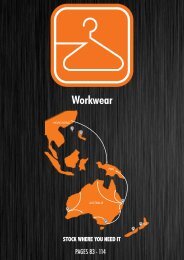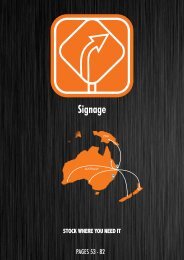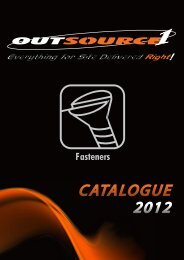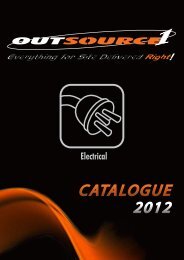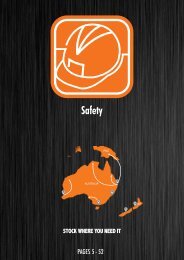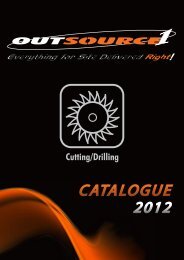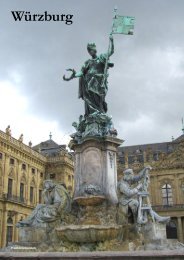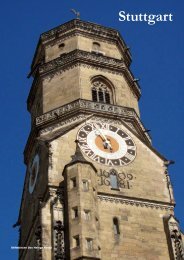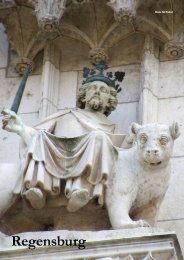Raven Guides: Germany - Trier
- No tags were found...
You also want an ePaper? Increase the reach of your titles
YUMPU automatically turns print PDFs into web optimized ePapers that Google loves.
M-Su 13.00, €6/5, children 6-14 €3) starts at<br />
the Porta Nigra and passes key sights including<br />
the Dom and the Konstantin-Basilika.<br />
Cruises<br />
Moselle round trips, half-day or day cruises<br />
are operated by Personenschiff Gebrüder Kolb<br />
(tel 0651-26666, www.moselrundfahrten.de)<br />
of Georg-Schmitt Platz 2. One or two-hour<br />
scenic cruises (May-Oct, €10 or €14) leave<br />
Zurlaubener Ufer on the city bank of the river<br />
north of Kaiser-Wilhelm-Brücke several times<br />
daily.<br />
Day return trips downstream to Bernkastel<br />
on the Moselle wine route (four hours 15<br />
minutes each way, €30) allow almost two<br />
hours in Bernkastel. There is also an offering<br />
of Saturday evening music cruises and voyages<br />
further downstream connecting Bernkastel,<br />
Cochem and Koblenz.<br />
Views<br />
Near the Mariensäule site off Auf der Jüngt on<br />
the 300m Markusberg is a lookout above the<br />
west bank of the Moselle. Take bus 10 to Auf<br />
der Jüngt or Mariensäule.<br />
The Petrisberg to the east of the Altstadt<br />
offers a closer view of the cathedral area (take<br />
bus 4 to Petrisberg Aussicht).<br />
A good view of the Altstadt is available<br />
from the top gallery of the Porta Nigra (see<br />
the Porta Nigra entry above).<br />
Parks & gardens<br />
The Palastgarten south of Kurfürstliches<br />
Palais was never completed and what was<br />
required refurbishment after World War II.<br />
But it is the most congenial of the green spaces<br />
around the Altstadt. Take bus 2, 10, 30, 33 or<br />
87 to Konstantin-Basilika.<br />
Nells Park, about 2km north-east of<br />
the city centre between Parkstraße and<br />
Metternichstraße, is an English garden layout<br />
with lake. Take bus 1 or 30 to Nells Park.<br />
Long walks are possible on the strip of<br />
the Moselle east bank, the most interesting<br />
sections being between the Römerbrücke and<br />
the historic homes of Zurlaubener Ufer to the<br />
north of Kaiser-Wilhelm-Brücke.<br />
Markets<br />
The market stalls of Hauptmarkt (M-F<br />
7-18.30, Sa 7-13) have fresh food and snacks<br />
and there are Tuesday and Friday farmers’<br />
markets at Viehmarktplatz (Apr-Sep 7-14,<br />
Oct-Mar 8-14).<br />
Events<br />
The Altstadtfest weekend at the end of<br />
June fills the main squares with live stage<br />
performances.<br />
The Advent-Christmas markets of <strong>Trier</strong>er<br />
Weihnachtsmarkt (M-W 10.30-20.30, Th-Sa<br />
10.30-21.30, Su 11-20.30) begin the last week<br />
of November at Hauptmarkt and Domfreihof<br />
and run until a few days before Christmas.<br />
Performance<br />
The annual Mosel Musikfestival is a series<br />
of regional events from July to December<br />
including concerts in <strong>Trier</strong>’s historic buildings<br />
such as the Großer Saal and courtyard in<br />
the Kurfürstliches Palais, the Dom St Peter,<br />
Liebfrauen-Basilika, Konstantin-Basilika and<br />
the church of St Paulin. The calendar and details<br />
are posted at www.moselmusikfestival<br />
.de.<br />
The Kurfürstliches Palais, built on the palace site of<br />
Roman rulers, was an electoral residence until 1794. The<br />
early 17th century north and east wings designed by Georg<br />
Ridinger shaped the Renaissance courtyard, the south wing<br />
(1761) being updated to Rococo by Johannes Seiz. This<br />
faces the Palastgarten and has an opulent staircase with<br />
sculptures by Ferdinand Tietz, who also crafted the original<br />
garden statues (now copied). When the archbishops moved<br />
their administration to Koblenz for good, French troops<br />
occupied the palace, which later was similarly used by the<br />
Prussians. The palace, restored after World War II damage,<br />
is still used for administration and interior viewing<br />
opportunities are few, but the Großer Saal is used for<br />
concerts. Take bus 2, 10, 30, 33 or 87 to Konstantin-Basilika.<br />
The Konstantin-Basilika (Apr-Oct M-Sa 10-18,<br />
Su 12-18, Nov-Mar Tu-Sa 11-12, 15-16, Su<br />
12-13, entry free) at Konstantinplatz is the<br />
largest (67m by 27m) surviving single-chamber<br />
structure of the Roman period, built about 310.<br />
It was the hall (aula palatina) where emperors<br />
received visitors in state. It was used as a castle<br />
by Frankish counts and as a palace by the<br />
medieval <strong>Trier</strong> archbishops before being partly<br />
torn down early in the 17th century during the<br />
remodelling of the Kurfürstliches Palais. In its<br />
1850s rebuilt form it was used for Evangelical church services, which with occasional<br />
concerts today restrict visitor access. The archaeology of other Roman structures shows<br />
in paving to the south and west. Take bus 2, 10, 30, 33 or 87 to Konstantin-Basilika.<br />
The Roter Turm (1647) at Konstantinplatz was<br />
built as an archive and chancellery, the last<br />
component of the Renaissance electoral palace<br />
complex to be completed. The tower was designed<br />
by Matthias Staudt. With the wall and the<br />
Petersburg-Portal to the south it was part of a<br />
structure enclosing a second palace courtyard to the<br />
north of the present Kurfürstliches Palais. A storey<br />
was added to the tower in 1830. After post-war<br />
restoration it is the bell tower for the Kirche zum<br />
Erlöser in the Konstantin-Basilika. Take bus 2, 10,<br />
30, 33 or 87 to Konstantin-Basilika.<br />
The Kaiserthermen bath complex (Apr-Sep<br />
M-Su 9-18, Mar & Oct M-Su 9-17, Nov-Feb<br />
M-Su 9-16, €3/2.10, visitors under 17 €1.50,<br />
families €6) south of the present Palastgarten<br />
was an unrealised project under Constantius<br />
Chlorus and left unfinished by his son<br />
Constantine, probably when the emperor left<br />
for eastern campaigns in 316. Before work<br />
was abandoned the caldarium at the east end<br />
reached about 20m. Today the engineering can<br />
be fully explored above ground from a raised platform and below through the tunnels. The<br />
emperor Valentinian I had the site adapted as barracks for about 500 mounted guards later<br />
in the 4th century. The site was adapted again in the 12th century when incorporated as<br />
the south-east bastion of a town wall. Take bus 2, 6, 7, 10, 16 or 30 to Kaiserthermen.<br />
The stands of the Roman amphitheatre (Apr-Sep<br />
M-Su 9-18, Mar & Oct M-Su 9-17, Nov-Feb M-Su<br />
9-16, €3/2.10, visitors under 17 €1.50, families €6) on<br />
Olewiger Straße could have seated 20,000 spectators<br />
late in the 2nd century. Here two Frankish kings taken<br />
prisoner were fed to beasts at the orders of Constantine.<br />
Underground holding chambers for staging gladiatorial<br />
combats and executions can be inspected, but care<br />
must be taken in many parts because of often-present<br />
groundwater. Much of the superstructure has<br />
disappeared but the masonry of vomitoria (exits) is<br />
intact. The stadium’s east embankment formed part<br />
of the Roman city wall and the south entrance was a<br />
city gate. Take bus 6, 7, 10, 16 or 30 to Amphitheater.<br />
RAVEN TRAVEL GUIDES GERMANY - <strong>Trier</strong> 5






